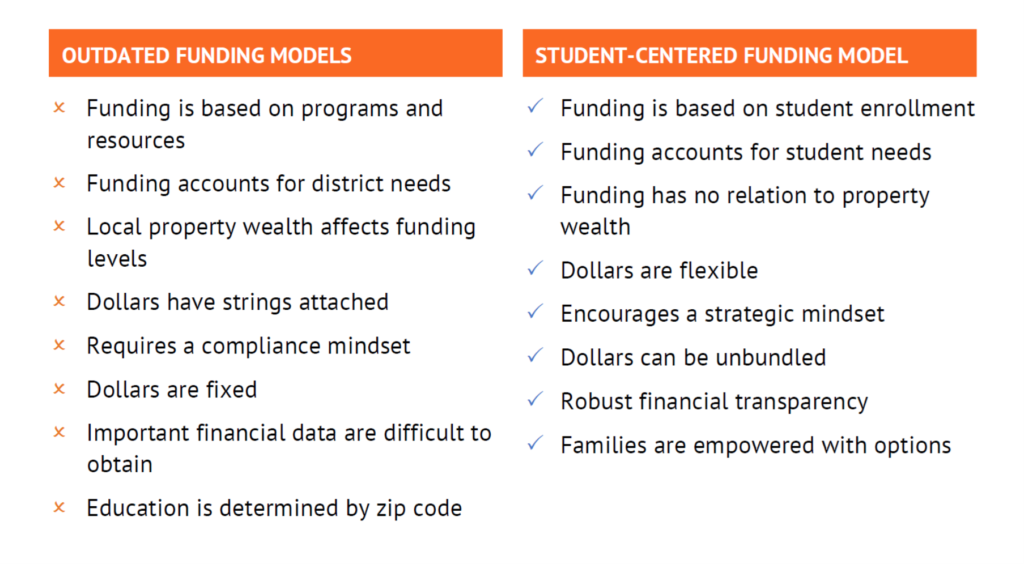School finance policy is the bedrock of education systems. Not only does it determine how much funding each community receives, but it also governs many aspects of how school districts and schools organize themselves and their learning environments—reaching each child directly.
But when there are cracks in the foundation, education dollars aren’t used as effectively as they could be to meet the unique needs of kids. A faulty foundation can also fund children unfairly and place important education decisions in the hands of those further away from classrooms.
To address these problems, states should move away from antiquated education funding models by adopting student-centered funding, which has several key advantages.
To realize these benefits, state policymakers must pursue four separate policy goals to fully adopt student-centered funding. These can be adopted separately over time or as a part of a comprehensive funding overhaul.
1. Streamline: Allocate education dollars based on students’ needs using a weighted student formula.
Most school finance formulas contain arbitrary and restrictive provisions that cause inequities and limit local discretion. A weighted student formula streamlines funding, ensuring dollars are delivered fairly while giving educators the flexibility to align school spending with students’ needs. The concept is simple: a per-pupil foundational allotment is established for regular program students and weights are added to this amount for selected categories of need such as poverty, English language learners, and special education.
California’s Local Control Funding Formula (LCFF) streamlined more than 30 categorical grants into a single weighted-student formula (WSF), which a study by Education Trust-West found to have helped drive substantial improvements in equity.
2. Equalize: Determine funding levels based on students, not by property wealth or zip code.
In many states, local property tax revenue causes funding disparities across school districts. Not only does this put kids on an uneven playing field, but it can also make it difficult to implement open enrollment programs that give families options across district boundaries.
It also means that charter schools, which typically don’t have access to local revenue, can be at a substantial financial disadvantage. There are several ways policymakers can equalize funding, such as replacing local property taxes with a statewide levy, limiting what school districts can raise locally, or implementing measures to ensure that local dollars follow the child to his or her school.
For example, education funding in Vermont is raised almost entirely at the state level using two statewide property tax levies—one for homesteads and another for non-homesteads. This alleviates disparities between school districts of varying property wealth and helps ensure that all kids are funded fairly.
Some states are also finding ways to give charter schools their fair share of local dollars. All school districts in Colorado must distribute a per-pupil share of any additional mill levy revenue raised to charters, and in Florida charters are eligible to receive a per-pupil share of local capital funding under certain conditions.
School leaders and families are best situated to make effective decisions with educational resources. However, state and K-12 school district policies too often limit local spending flexibility, leading to a situation where, according to a recent study from the American Institutes for Research, the average school principal has discretion over only 8 percent of their operational budget.
Instead, state policymakers should empower school district leaders by delivering most resources as unrestricted weighted student funding, as California’s Local Control Funding Formula does (LCFF). Research indicates wide support for this approach and has found that it has led to positive cultural shifts within school districts—with 82 percent of superintendents agreeing that that LCFF allows them to better align goals, strategies, and resource allocation decisions.
Families are also restricted, as it’s often difficult, if not impossible, for kids to attend schools across catchment areas or district boundaries. To address this, policymakers can look to Florida’s Controlled Open Enrollment law, which allows kids to enroll in any public school in the state with a few restrictions. Available data on the program are promising and show an increase in participation of more than 50 percent since its implementation in 2016—with over 90 percent transferring to A- or B-rated school districts.
4. Inform: Shine a light on how education dollars are allocated and spent.
Public education stakeholders often don’t have access to basic financial data that are vital to making sound decisions. While budgets and financial statements are typically available, these documents are cumbersome and provide little context or meaning, making it difficult to compare trends across districts or schools. This is problematic, since education dollars are often allocated unfairly among school districts, and research also shows that district formulas sometimes shortchange students in low-income communities.
Not only does robust transparency highlight these funding inequities, but it can also be used to replace top-down spending mandates that limit local flexibility over how dollars are spent. Policymakers should create a financial reporting system in which data are actionable and readily available in a centralized location. This can range from providing simple dashboards that provide meaningful comparisons to more-comprehensive platforms that integrate numerous data sources. Reports can include data on metrics such as funding equity, spending trends, school-level expenditures, right-sizing, open enrollment trends, and school capacity.
While each of these four reforms can be good for students on its own, it’s important to understand that they are most effective when put together. It’s easier to empower local leaders and allow families to move to the school of their choice when funding isn’t heavily dependent on zip codes. Similarly, it’s easier to fund all children fairly when disjointed, ad hoc school finance systems are simplified and streamlined. Even further, it’s easier for families and empowered leaders to make good decisions for students when they have access to high-quality financial data.
The vision is to have a school finance system that not only treats every child more fairly but also better recognizes students’ individuality and allows for innovation and progress.
Student-Centered Funding Roadmap for Policymakers
Reason Foundation’s series of policy briefs on the Student-Centered Funding Roadmap for Policymakers includes:
- A Student-Centered Funding Roadmap for Policymakers
- Streamline: How to Allocate Education Dollars Strategically
- Equalize: Funding Policies That Put All Kids on a Level Playing Field
- Empower: How to Put Families and School Leaders in the Driver’s Seat
- Inform: Give Stakeholders the Information They Need to Make Sound Education Funding Decisions



